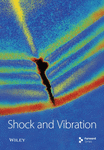Health Monitoring of Thick Materials Using Piezoceramic Patches, Time Signals, and Wavelet Transmittance Functions
Abstract
A relatively overlooked factor in both global and local methods of health monitoring is the nonlinear stiffness of structures caused by the cycling of cracks and delaminations. Global methods of health monitoring use modal parameters or frequency response functions in an inverse procedure to quantify damage in structures with thick sections. Global approaches use fewer sensors that detect only significantly large damage in structures due to damage caused by transient vibration. However, local methods use Lamb wave propagation to detect small damage within a structure by an array of closely spaced sensors and actuators. Local methods also become more difficult to use on thick or non-homogeneous materials because wave propagation becomes complex. This paper develops a combined time series and wavelet analysis technique to improve damage detection in either thick, complex geometry, or non-homogeneous materials. A wavelet transmittance function (WTF) is defined as the ratio of continuous wavelet transforms from the time responses at different locations on a structure. A new damage indicator was developed based upon wavelet transmittance function. The novelty of the method lies in the fact that a near real time inference about the damage and the approximate extent of damage can be drawn without historical data. A simulated model is illustrated to highlight the potential of the new damage indicator on a thick aluminum specimen. Then, experimental signal data from two sets of different experiments conducted on thick structures with a crack and a delamination were analyzed using the wavelet transmittance function to detect the presence and extent of the damages as reflected on the WTF maps. This paper mainly deals with the development of WTF and the associated damage indicator by analyzing the simulated and experimental sets of data.




